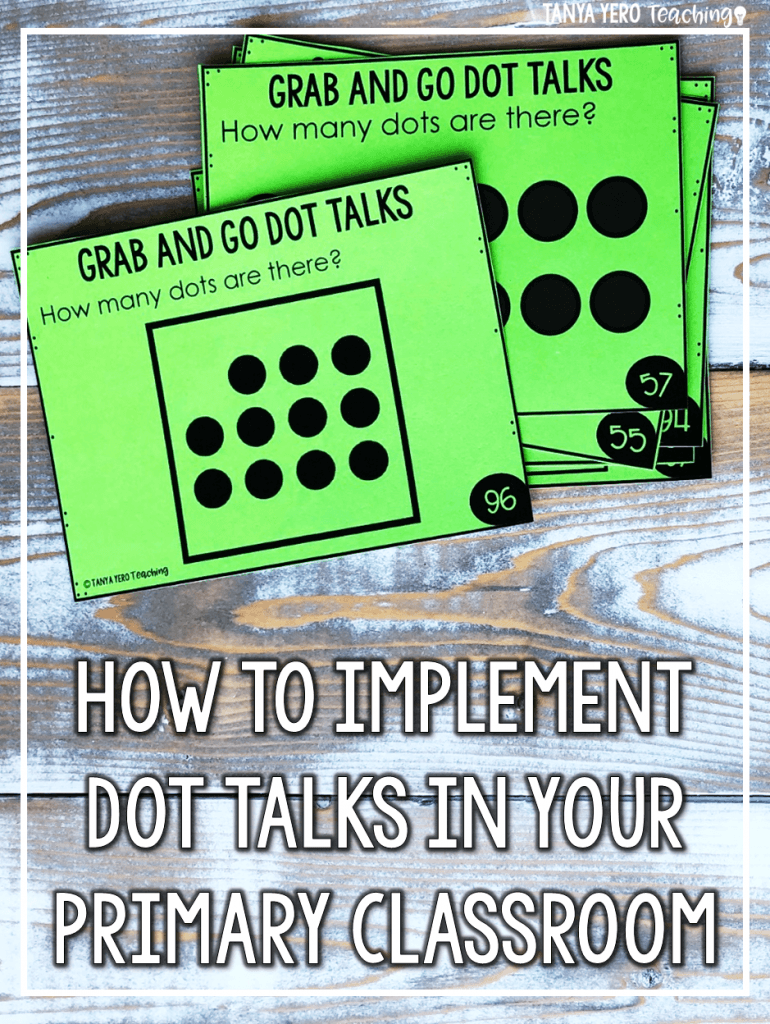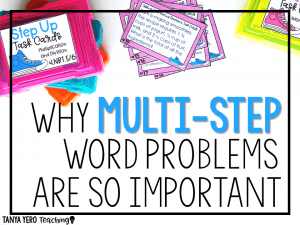Dot talks are an off-shoot of the daily classroom number concepts called “number talks.” Dot talks can be incorporated into number talks, and can be used with students of any age. But because subitizing is such an important developmental skill, they are uniquely suited to meeting the needs of kindergarten minds.
Why We Implement Dot Talks
Subitizing is the ability to look at a number of objects and “know” how many there are. Some subitizing is perceptual, such as when we recognize this pattern of dots on a die as five.
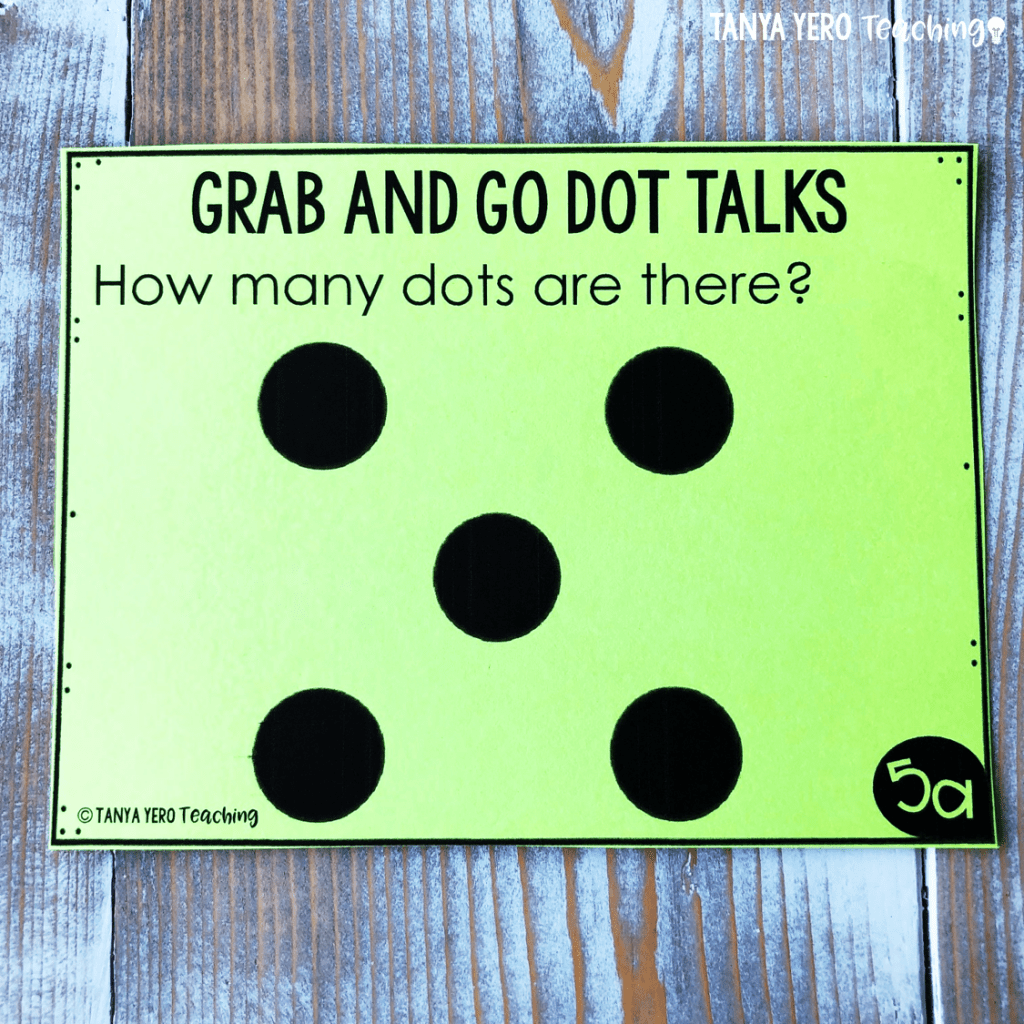
Conceptual subitizing is recognizing smaller sets within a larger number of items and quickly adding them together.
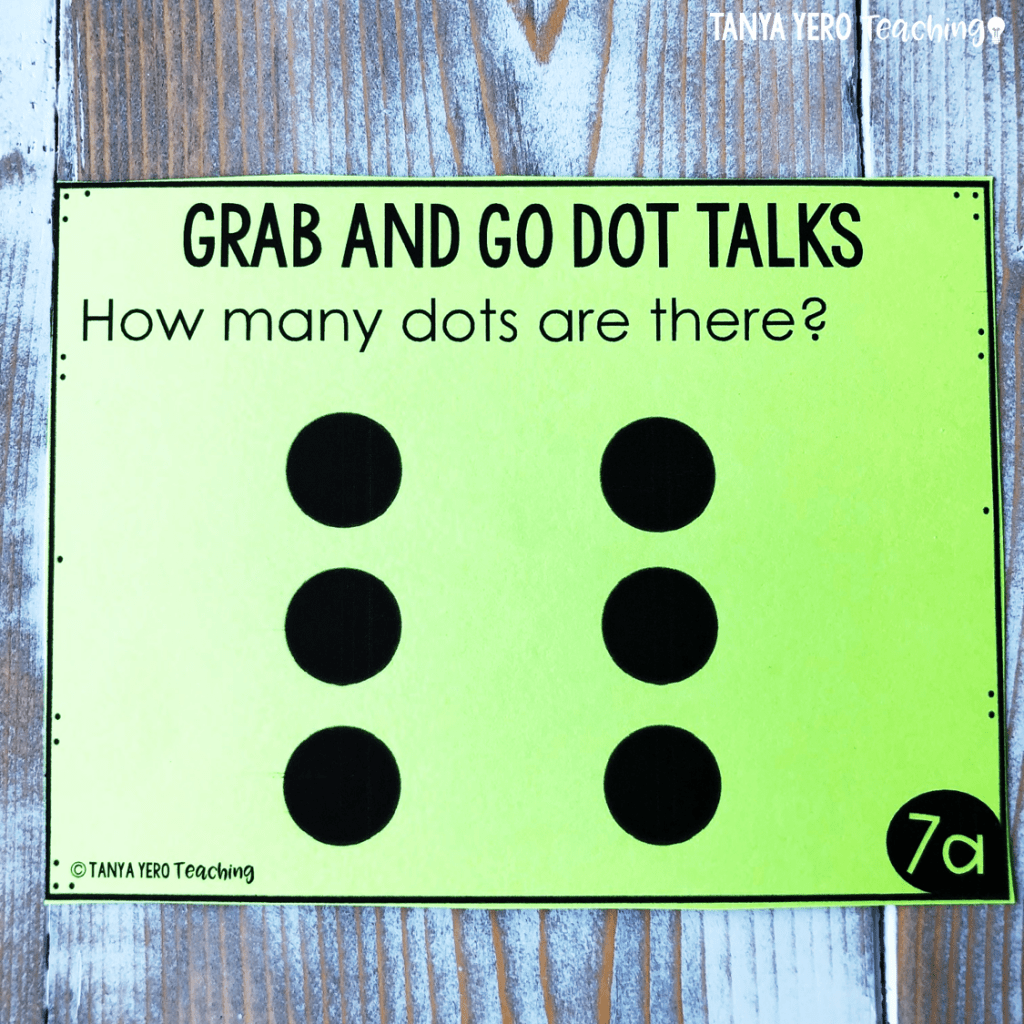
Looking at the 6 side on a die, we see 3 and 3, which we know is 6.
What are Dot Talks?
Dot talks are short, routine class meetings that help children build number sense, articulate their thinking, and appreciate different perspectives. They should be scheduled as a regular part of your day and flexible enough to expand with the children in your class or group. When dot talks are first implemented, especially if it is early kindergarten, they will take only a few minutes. Later on, as children learn the process, build their skills, and develop confidence, you may be struggling to keep it under 20 minutes.
Beginning training for dot talks is almost painfully simple. You present a card with 1 dot on it for a moment, and ask the students, “How many dots are there?” They will see 1 dot and can prove their thinking by touching the dot and counting, “one.” You can vary this first lesson by presenting dots in different places around the page or card. This fosters the additional critical understanding that sets can change shape or orientation, but only change if something is added or taken away.
Starting with the set of 2 dots, more conversational possibilities open up. Two can be subitized (I just know it), but it can also be decomposed (I know 1 and 1 is 2). Presenting the dots in different locations around the page does not change their “two-ness” or their “1 plus 1-ness.”
What Do Dot Talks Look Like In The Classroom?
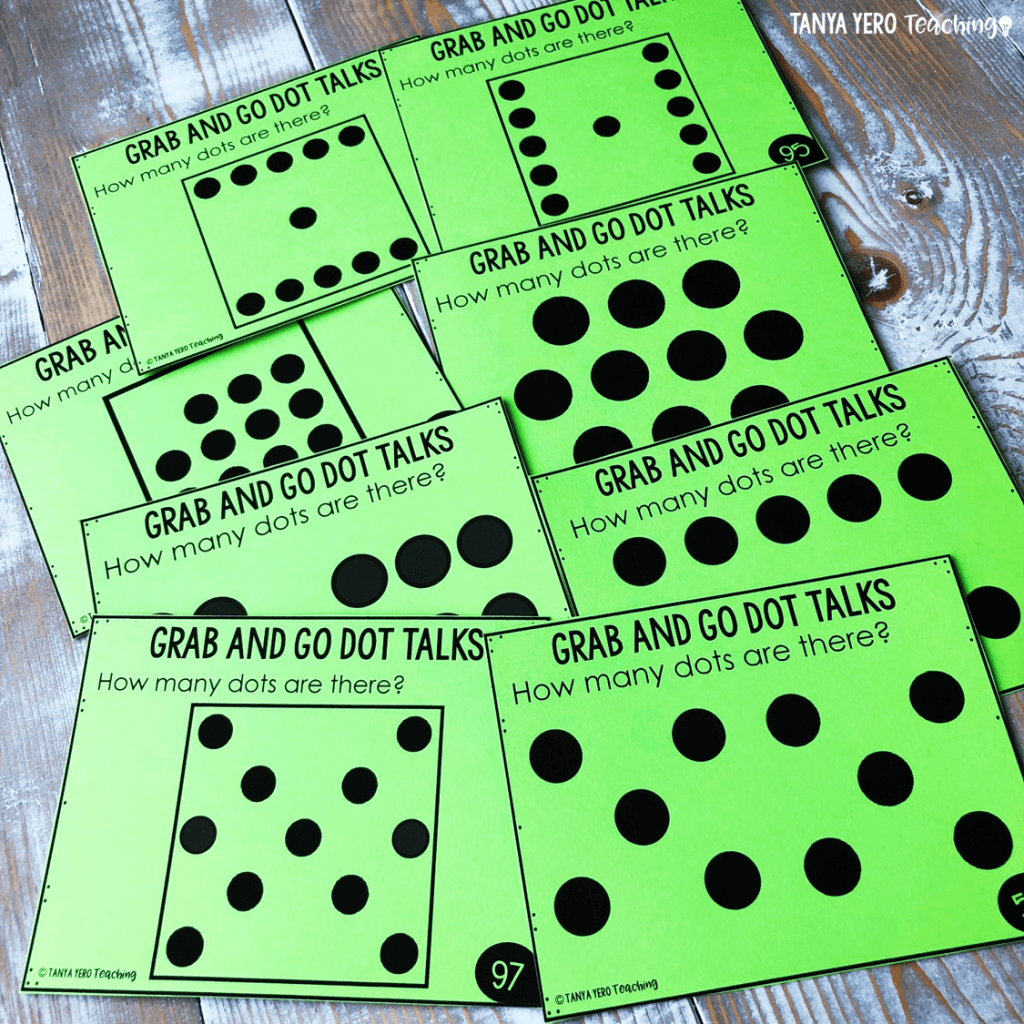
Starting this routine in the beginning of the year is ideal (but not mandatory) because the complexity of numbers and placement of dots can grow naturally with the children’s development. The early stages of dot talks address Counting and Cardinality standards 4 and 5, understanding the relationship between counting and cardinality, and counting to answer “How many?” As the number of dots you are using increases, so does the range of activities you can introduce with them. Here are our favorite nine dot-talk activities for the kindergarten classroom:
- How many dots are there? Hold the dot card up briefly. Students look at the card, but don’t count the dots (of course, they will in the beginning). Ask, “How many dots are there?” Record or discuss students’ observations. Follow up with, “How do you see them?” Students will explain how they saw groups that they added up to the whole. Dot talks start out very simple! Your students are learning how to do Dot Talks and learning how to complete the question-answer process. Over time, as the numbers get more complex and the children develop their skills, a single dot talk card can take as long as 15 minutes to complete! Dot talks for 1, 2, and 3 dots can be used for training your class in the process. You will model strategies, self-talk, and reasoning aloud. Early on, each number can be presented in a variety of arrangements so children can experience a variety of strategies. You can certainly buy specially made dot-talk cards. In the beginning, it is also easy to use a marker and an index card!
- Which number doesn’t belong? Starting this activity early on is great, because the visual representation is easy to differentiate in small sets. For example, the difference between 2 dots and 4 dots is clear. This activity requires a set of 4 cards. 3 of the cards have the same number of dots. 1 card is different. Children briefly look at each card, and then it is flipped. Children “see” the difference by subitizing the dots on each card. Children share their thinking and how they knew which card didn’t belong. This activity quickly builds confidence in young learners, which in turn builds excitement for dot talks, and math in general.
- How did the number change? This activity is presented in sets of 2 cards each. Children look at the first card briefly. The card is flipped, and a different number of dots is displayed. Children explain how the number changed. For example, there may be a new dot on the 2nd card. One dot may have been subtracted. Again, children rely on subitizing to come up with the answer and develop their reasoning/articulation skills through the reporting process. This activity supports Operations and Algebraic Thinking standards 1, 2, and 5.
- Secret Partners addresses the Operations and Algebraic Thinking standards 1, 2, and 5, as well as standard 3 which asks children to decompose bigger numbers. Starting with 2 dots, children report the “secret partners” that make the bigger number. For 2 it is 1 and 1, but as the numbers get bigger, the possible addends increase rapidly! This activity really illustrates students using different strategies, which is another important part of dot talks.
- How many more to 10? 10-frames are great because they form a number-sense foundation of 10 that is easy (over time) for students to subitize. Using dots in a 10-frame, children find the missing addend to ten, Operations and Algebraic Thinking standard 4. After plenty of practice, the sum total goes up to 20! With plenty of visual support and practice, your students will master this activity.
- Strategies to count scattered dots addresses Counting & Cardinality standard 5. It also provides an opportunity for your students to utilize and then share different strategies for solving the dot card. Starting with small numbers, students look at how changing placement doesn’t change numbers. As the numbers get more complex, students use and share strategies to group scattered dots. Subitizing works best with well-organized dots. This activity provides a challenge.
- How many dots are there? with 10-frames is introduced well into the year, as the numbers start to spill into the teens. These cards can be used in conjunction with subitizing cards. Students can compare and contrast subitizing larger numbers without a frame and with a frame. This activity addresses Counting & Cardinality standards 4 and 5 as well as NBT standard 1.
- Dice Dots Addition cards present dots on dice. The dots are somewhat separated and address composing numbers, number sense, and addition fluency. Children continue to build a conceptual bridge between the strategies they use for the dot cards and using formal operations.
- How Many Groups of 10? This activity is designed to grow with your students. Presented mid- to late in the year, students can build on their hard word developing an understanding of numbers to 100! Counting and Cardinality standard 1 is a monster, and this activity can take your students to the finish line.
Students use their subitizing skills to count full 10-frames for groups of 10. It also helps children get familiar with talking about groups of 10.
I hope these activity ideas give you a sense of how powerful dots talks and number talks can be in your classroom. As an integrated part of your math instruction, dot talks push children’s thinking, knowing, and reasoning skills. If you are looking for another math element to take your classroom math practice from great to superb, dot talks might be for you. Check out our Dot Talks resource in our TpT store for print and ready resources!

